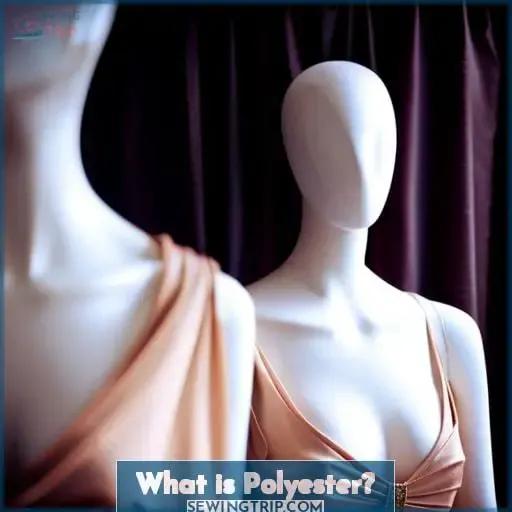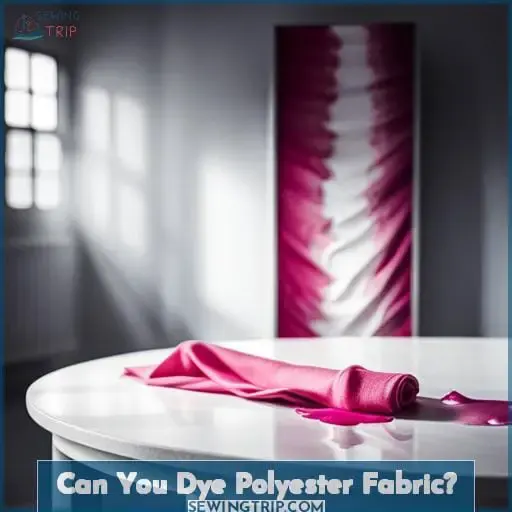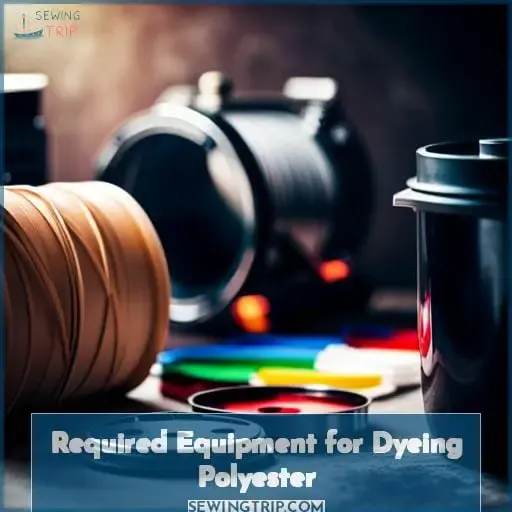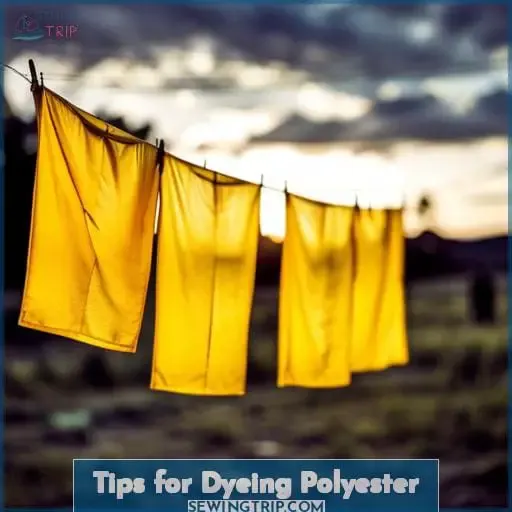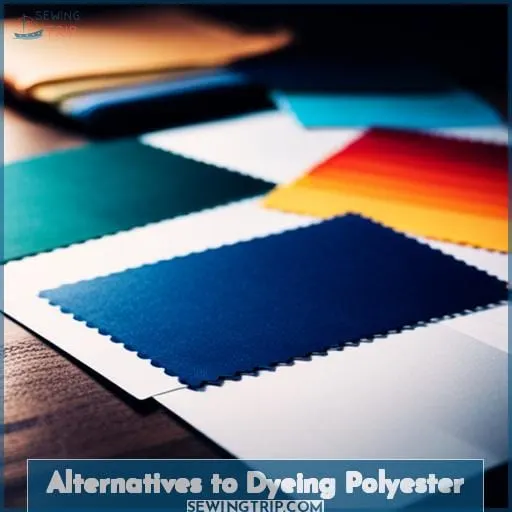This site is supported by our readers. We may earn a commission, at no cost to you, if you purchase through links.
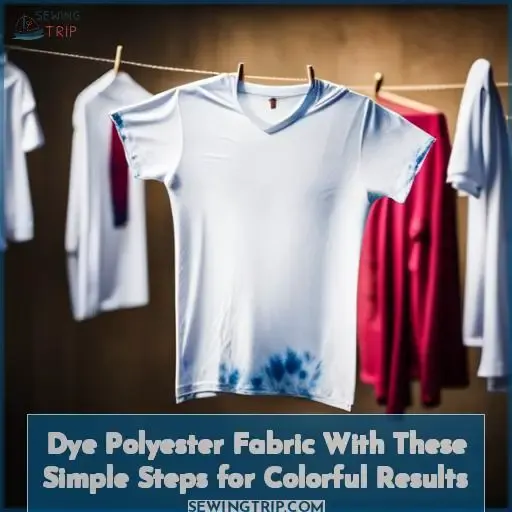 Resisting the pull of the force at the other end of our soul’s thread, we wield the power to reinvent.
Resisting the pull of the force at the other end of our soul’s thread, we wield the power to reinvent.
Though synthetic fibers seem immutable, plunge polyester into boiling waters of transformation, let color permeate its being, and marvel as its true nature emerges.
We need not accept the fabric as it appears – through dye, we shape its destiny.
Even polyester can be reborn.
Table Of Contents
What is Polyester?
Your synthetically manufactured polyester fabric comes from chemical compounds that are artificially spun into a polymer fiber.
Polyester offers properties that make it a popular choice for fashion and function.
Its hydrophobic structure wicks moisture and dries quickly while retaining shape and resisting shrinking.
Blends with natural fibers balance polyester’s sturdy, wrinkle-resistant structure with softness and breathability.
Polyester’s versatility allows it to be fashioned into diverse textiles from weatherproof outerwear to diaphanous evening gowns.
Yet to unleash polyester’s potential for saturated color requires specially formulated dyes and high temperatures to permeate the synthetic polymer fibers.
With the right dyes and proper technique, polyester can become a blank canvas for creating vibrantly hued garments and accessories.
Can You Dye Polyester Fabric?
Yes, you can absolutely dye polyester fabric for vibrant colors.
Be sure to use dyes made for synthetics like Rit DyeMore and get the water hot enough to open the polyester fibers.
Dyeing polyester in your washing machine works too but gives you less control over the final results.
Best Dyes for Polyester
But you can dye polyester fabric if you use the right kind of dye.
Rit DyeMore and iDye Poly give excellent lightfastness and colorfastness when dyeing polyester fabric.
Follow package directions and use the stovetop method to boil your fabric in the dye bath for vivid, long-lasting color on polyester.
Using the right dyes and method allows you to successfully dye polyester for colorful results.
Dyeing Polyester in a Washing Machine
Although polyester fabric doesn’t absorb dye as easily as natural fibers, you can absolutely dye it in your washing machine if you’re okay with having less control over the final results.
Food coloring, Kool-Aid, acrylic paint, and even spray paint can all be used to dye polyester when following package directions.
Test on swatches first and be prepared for unexpected colors from mixing.
Required Equipment for Dyeing Polyester
You’ll need a few basic supplies to dye polyester fabric:
- A large stainless steel pot to heat the dye bath
- Stainless steel utensils to stir and handle the wet fabric
- An appropriate polyester dye
Follow the dye manufacturer’s instructions for any other special equipment needed for the particular dye you select.
Heat Source
Precision demands a stovetop or other heat source able to reach over 200 degrees Fahrenheit when dyeing polyester fabric.
Use a burner, microwave, crockpot, or campfire to apply disperse dye to fabric.
Follow package directions for stovetop dyeing to prevent sun damage.
Dye Pot
You’ll need a dye pot to dye polyester fabric.
When selecting a dye pot, choose a large stainless steel stockpot dedicated solely to dyeing. This allows you to safely heat the dye bath to the high temperatures needed to set the dye on synthetic fibers.
Dye Pot Size
- Large enough to allow fabric to move freely
Dye Pot Material
- Stainless steel
Dye Pot Cleaning
- Soft scrub cleanser like Barkeeper’s Friend
Dye Pot Storage
- Safe spot away from food prep areas
Dye Pot Alternatives
- Small loaf pan for test swatches
Utensils
Two utensils you’ll need for dyeing polyester are a stockpot and tongs.
Rubber gloves and tongs enable handling the hot fabric and dye safely.
Choose wooden spoons and dye brushes specifically for fabric dye to avoid cross contamination.
Select sturdy tongs and spoons that can withstand high temperatures.
Never use these for food preparation again.
How to Dye Polyester Step-by-Step
Now that you’ve gathered the necessary supplies, it’s time to dye! Follow these simple steps for vibrant color on polyester:
- Fill a pot with enough water to submerge the fabric and bring to a boil. Add 1-2 bottles of Rit DyeMore, depending on intensity desired.
- Reduce heat to a simmer, then submerge your polyester for 30-60 minutes, stirring occasionally with tongs.
- After dyeing, rinse thoroughly with cool water until it runs clear.
- Lastly, wash with detergent in cold water and let air dry for a freshly dyed creation! With these straightforward steps, you’ll achieve beautiful custom color on polyester.
Tips for Dyeing Polyester
When dyeing polyester, first test the dye on a small swatch of fabric.
Carefully follow the directions on the dye package for best results, as polyester can be tricky. Pay close attention to the recommended water temperature and dyeing time for the fiber content.
Testing First
Make a test swatch from a scrap of your fabric before dyeing the whole thing so you can perfect the technique and color.
- Try a hidden area inside a hem or seam.
- Test with a white cloth if your garment isn’t white – you’ll see the true hue emerge.
Swatching first prevents surprises and disappointments when dyeing.
Always experiment on scraps when playing with new techniques or colors.
Following Directions
You’ll want to follow the package directions carefully when dyeing polyester.
Don’t over boil, use too much dye, or stir constantly to prevent uneven results.
Test dye first on a swatch.
Rinse thoroughly after dyeing and don’t let the pot boil dry.
Precision is key for vibrant, even color.
Things to Consider When Dyeing Polyester
If you want to dye polyester that’s already been dyed, the original color will affect the final result.
When mixing dye colors for polyester, remember they’ll blend and interact, not layer.
Test samples first to preview effects of overdyeing and color mixing when dyeing polyester fabric.
Previously Dyed Fabric
With a previously dyed fabric, you’d need to take into account that:
- Overdyeing with a darker color may be the only option, as lighter colors likely won’t take or could create muddy, unintended tones.
- Multiple colors from tie dye or patterns and logos will mix, so be aware of potential bleeding.
- Neon and metallic dyes react differently, so test first for best colorfastness.
Mixing Dye Colors
The blending of dyes requires your awareness that new hues will emerge from combining the pigments.
When mixing primary colors, you can create a full rainbow of secondary and tertiary colors.
Combining analogous colors like red and orange produces vibrant, harmonious results.
Mixing complementary colors like blue and orange makes both stand out more.
Split complementary and triadic color schemes also yield exciting, eye-catching effects.
Thoughtfully blending dyes expands your palette dramatically.
Cleaning Up After Dyeing Polyester
After your dyeing project, be sure to immediately clean your dye pot, tongs, and sink thoroughly.
- Scrub your sink with a soft cleanser to remove all traces of dye.
- Do the same for your dye pot and tongs, taking care to remove any clinging dye particles.
- Dry the pot and tongs right away to prevent rusting.
Find a dedicated spot to store your dye supplies, safely away from food prep areas, to avoid cross-contamination.
With the right cleaning methods, you can ensure your dye session leaves no lingering stains or rust. Store your supplies properly, and you’ll be ready to easily dye again when inspiration strikes.
Alternatives to Dyeing Polyester
You can try other methods besides dye if you want to color polyester fabric. Here are 4 alternative techniques to consider:
- Fabric paint – Acrylic fabric paint can be used to create designs. Make sure to heat set it after.
- Spray paint – You can use spray paint for an ombre look. Just mask off areas you don’t want painted.
- Bleach – For a cool tie-dye effect, scrunch fabric and spray with bleach. Rinse thoroughly after.
- Vinyl – Adhere colorful heat transfer vinyl to polyester with an iron or heat press. The vinyl will stick permanently.
Experiment with fabric paint, spray paint, bleach, and vinyl if you want to customize polyester without traditional dye.
Conclusion
Polyester may seem immutable, but with the right dyes and techniques, you can reinvent its nature.
By following precise directions, even novices can safely transform polyester through immersion in hot dye baths.
With some simple tools and materials, unleash your inner textile artist.
Over 60% of clothing contains polyester, offering ample opportunities for experimentation.
So grab your dye pots – with an open mind, polyester’s destiny is yours to shape.

